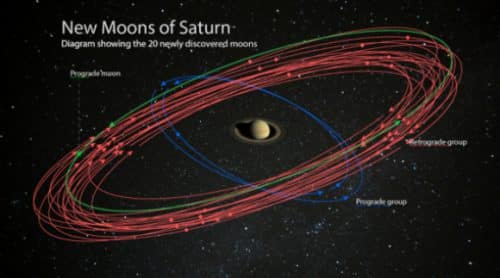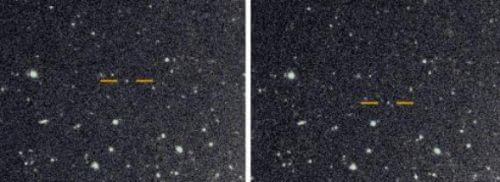Researchers in the United States have discovered twenty more unknown moons of the planet Saturn. This brought the number of its moons to 82, and it passed the largest planet in the solar system, Jupiter, around which 79 moons have been identified so far. The researchers, led by Scott Sheppard from the Carnegie Institution in Washington, identified the small moons through a careful analysis of ground-based telescope images, especially the large telescope in Hawaii. Last year this team completed the identification of ten unknown moons of Jupiter. The number of discoveries in recent years suggests that the number is obviously not final, and many more moons may be discovered as the field of telescopes improves.

divide into groups
The twenty discovered moons are quite small, each about five kilometers in diameter, and they orbit Saturn in a relatively distant orbit, outside of its famous ring system. Of the twenty, the moons closer to Saturn complete the orbit around it in about two years, and the more distant ones complete the orbit in about three Earth years.
17 of the discovered moons orbit Saturn in the opposite direction from the self-rotation of the planet (retrograde), thus they join the group of Saturn's moons known as the "Norse group", because their names are taken from Norse mythology. All the moons in this group orbit Saturn in the "opposite" direction, which strengthens the theory that they are actually fragments of an ancient moon that disintegrated. "The formation of such groups of outer moons is also seen around Jupiter, and it probably indicates violent collisions that took place between Saturn's moons, or collisions of ancient moons with external factors, for example asteroids or comets," Shepherd explained.
Two of the other three moons also belong to a defined group of moons, known as the "Inuit group", again, after the mythology from which the names of the moons were taken. These are moons orbiting Saturn with its direction of rotation (prograde), at a relatively sharp angle to its orbit (about 46 degrees), and in a more inner orbit than most of the other moons, but still far outside the rings. They too are probably remnants of a larger moon that disintegrated in a violent collision.
The twentieth moon orbits Saturn with its direction of rotation, at an angle that corresponds to the group of moons known as the "Galic group", but in an orbit far from the rest of the moons in the group, so it is not clear if it was indeed formed from the same source.

Late formation
"The study of the orbits of these moons may reveal the way they formed and shed light on the conditions around Saturn at the time of their formation," Shepherd said. According to today's accepted explanation, the planets were formed from a flat cloud (disk) of gas and dust that remained around the Sun after its formation, and the moons of the major planets were similarly formed from the excess dust and gas that remained around them. According to Shepard, the abundance of dust and gas during the disintegration of moons would have caused a lot of friction with their fragments and slowed down their speed until they were eventually engulfed by Saturn itself. "The fact that the moons that have now been discovered continued to orbit Saturn after the disintegration of the moons from which they were formed, indicates that the disintegrations occurred at a late stage of the planet's formation, after the gas and dust were no longer a significant factor," Shepard concluded.
Following the discovery, the Carnegie Institution invites the public to suggest names for Saturn's moons. The institute launched a public competition, with the conditions being the selection of names of giants from the relevant mythologies. 17 moons will receive giant names from Norse mythology, two from Inuit mythology and one from Gaelic mythology. You can submit names for the competition until December 6 this year. The full details of Saturn's moons, including the newly discovered ones, can be found here.
For science updates from the Davidson Institute website on the Telegram channel או At watsap

3 תגובות
What a miracle of God, blessed be He, that in one month they find out a month ago that a ball was swallowed, and a month later they find moons, all this is a hint of the coming of the Messiah soon. I wish all the Jews would repent and know the Torah that she watched
In advance the science that is currently coming to us by the way geometry 79 moons seven plus nine 16 one plus six equals seven conclusion observance of Shabbat 7 for a hint of the very near redemption
The moons that move in the opposite direction were not formed from the original cloud from which Saturn was formed (because it all moves in the same direction). but from a moon or moons that Saturn "captured" after its creation.
Likewise for the "Inuit group",
Very interesting